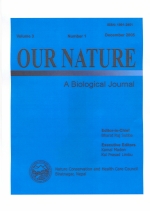Comparative Analysis of the Flora of Morang District and Adjoining Areas of Nepal
DOI:
https://doi.org/10.3126/on.v3i1.336Keywords:
Conservation, Exotic weeds, Floristic analysis, Life forms, Reproductive seasonsAbstract
Nine hundred and forty seven species of vascular plants under 661 genera and 172 families were recorded from Morang district and adjoining areas of Nepal. The genus-species ratio of the vascular plants in general and angiosperms in particular was 1:1.43 and 1:1.44, respectively; and 498 genera of vascular plants were represented by a single species only. On the basis of number of species, Polypodiaceae (11) was the largest family of pteridophytes, and Pinaceae (3) of gymnosperms. Among the angiosperms ten largest families were: Leguminosae (91)>Poaceae (80)> Asteraceae (57)>Euphorbiaceae (31)> Cyperaceae (28)> Rubiaceae(26) > Lamiaceae and Solanaceae (22 each) > Acanthaceae (21)> Orchidaceae (20) > Convolvulaceae (16). The biological spectrum of the study area was phanerotherophytic type.
Key words: Conservation, Exotic weeds, Floristic analysis, Life forms, Reproductive seasons
doi:10.3126/on.v3i1.336
Our Nature (2005) 3: 63-68
Downloads
Downloads
How to Cite
Issue
Section
License
This license enables reusers to distribute, remix, adapt, and build upon the material in any medium or format for noncommercial purposes only, and only so long as attribution is given to the creator.




